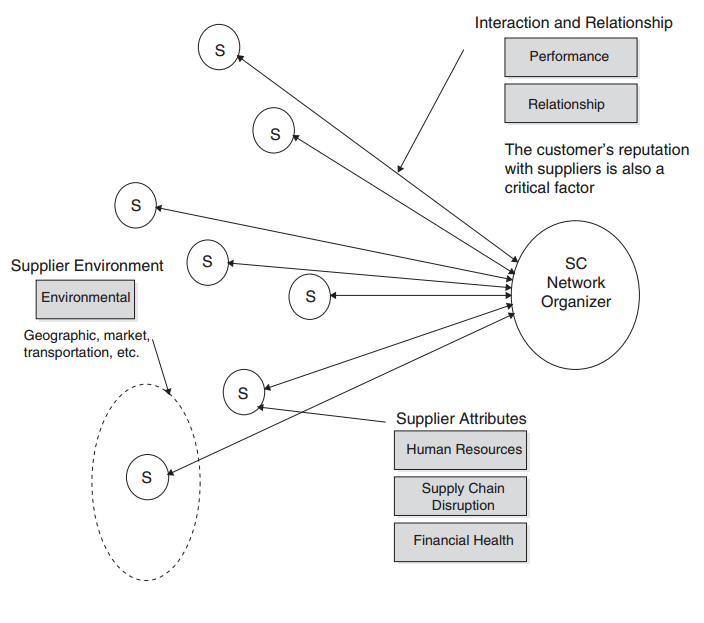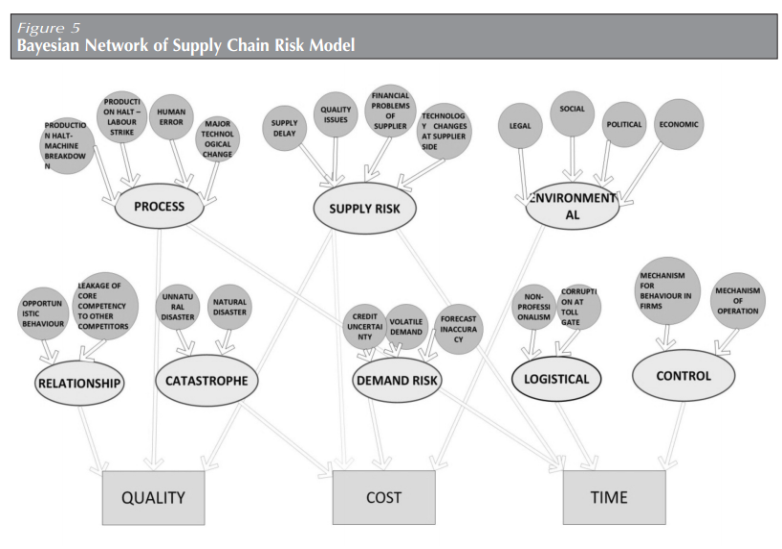Abstract
Operating in the context of the global economy realm implies dealing with several risks. Mitigating these risks is crucial to the success of the company, yet the number of factors that determine the severity of the threat is very large. Therefore, there is a need to introduce the framework that would help manage the global threats and reduce the risks that a firm may face. Sharma and Sharma, as well as Lockamy, consider the use of the Bayesian network as the means of mitigating risks in the supply chain by improving the information management strategies and addressing the communication issue.
Introduction of Articles
Managing supply chains (SC) in the context of the global economic environment is a challenging task. Because of the array of factors that need to be taken into account, including the economic, political, social, and cultural ones, addressing the existing risks becomes an increasingly convoluted procedure.
The Bayesian model (BM) for mitigating risks in the context of the global market can be viewed as the solution to some of the associated issues. Sharma and Sharma, as well as Lockamy (756), tackle the issue of introducing the Bayesian framework into the realm of the target market and using it as the means of improving the operations within the global SC. Therefore, determining the efficacy of the BM as the tool for mitigating risks and creating a safer economic environment for a company to operate in can be considered the primary motivation of the authors of both articles.
According to the authors, the model in question allows for managing the problem of the SC vulnerability, which is especially topical nowadays (Sharma and Sharma 51). Particularly, Sharma and Sharma (53) point to the fact that there is a lack of understanding of how to make efficient use of the available information in most organizations, which ultimately leads to their untimely demise. The BM, in its turn, is supposed to help introduce a better data management approach into the company, therefore, creating prerequisites for success.
Lockamy (756), in his turn, goes even further by claiming that the BM is bound to help handle the disaster-related risks. Specifically, the framework helps improve the communication process with suppliers so that the company could retrieve the necessary information within the shortest amount of time possible and reallocate the resources. As a result, even when facing drastic circumstances, an organization remains capable of managing its key operations and remaining stable in the global economy by using its resources and distributing them based on the needs of the corresponding departments. As a result, most of the firm’s operations remain supported.
Nomenclature
- BM = Bayesian model
- SC = SC
- IM = information management
Explanation of the work presented in journal articles
This section explains the articles you reviewed.
Article I
Lockamy (761) proves that the Bayesian framework can be used successfully to improve the essential operations within global SC. Particularly the author stresses the significance of using the model as the means of building relationships with the suppliers so that the disaster risks associated with the operations in the designated environment could be mitigated successfully. For instance, the tool in question helps detect the correlation between the impact of the supplier on the company’s operations and the revenue of the entrepreneurship. The author admits that mitigating the disaster-associated risks completely with the help of the Bayesian tool is not a possibility, yet the threats can be reduced to a considerable extent as the model helps evaluate the profile of the supplier and, thus, define the prospective issues.
Article II
Sharma and Sharma (51), in their turn, address the issue of disruptive risk factors in the environment of the global economy and use the BM as the tool for determining the extent to which the success of a company is jeopardized. The authors put a much stronger emphasis on the issue of information management (IM); as a result, the risks are identified at all of the SC management levels, including the logistics, the environment, the demand, the relationship, etc. The authors build a structural model that shows quite explicitly that the time variable is the least affected by the constraints and the negative factors that a firm is exposed to in the target market. Furthermore, the credit uncertainty and the forecast inaccuracy factors affect the demand risk, thus, reducing the firm’s ability to respond to the needs of the customers in a timely and efficient manner.
Relationship of select articles
Although both articles address the same topic, there are more than the similarities in the subject of discussion to the papers under analysis. Both studies render the same issue of the vulnerabilities to which the companies operating in the environment of the global economy are exposed. Specifically, the problem regarding the IM systems and the threats that they include is rendered in the papers under analysis. The studies point to the fact that the approach known as the BM can be viewed as the solution to some of the most topical issues in the target environment. Furthermore, the papers address the issue of resource allocation, pointing to the fact that dire circumstances require a sustainable use of corporate assets.
Discussion of Contributions
Contributions of Article I
Lockamy (761) creates the assessment model that can be used as the means of improving the decision-making process in the context of the global SC management process. Based on the concepts of interactions and relationships, the model stresses the importance of communicating successfully with the company’s stakeholders, including not only suppliers but also buyers. Although the latter is not brought up often in the article, they are not left out of the equation; quite on the contrary Lockamy (755) makes it clear that the significance of the buyers’ choices is extremely high for the company’s success in the target market.
By quantifying the indicators related to the customers and the suppliers, Lockamy (758) builds the model that implies creating a network in which the communication process between the key stakeholders could occur in an uninhibited fashion. Furthermore, the author stresses the fact that the customer’s reputation with suppliers serves as an important factor in the design of the network and the further organization of the communication process (see Fig. 1).

Contributions of Article II
Sharma and Sharma (53) build a comprehensive Bayesian Network of SC Risk Model, therefore, embracing every single factor that a company is affected by in the realm of the global economy. Three crucial items according to which the assessment is carried out are detailed in the framework under analysis; according to the author, these are the time, the costs, and the quality of the end product or service. The model can be deemed as fairly detailed; outlining the key processes occurring in the company, it displays the significance of making sure that the IM within an organization are carried out impeccably. Indeed, according to the framework, there is a need to make sure that the operations of the identified departments of the company should be well-coordinated (see Fig. 2). Without a substantial data management strategy that will help maintain unceasing data flow in the organization, the coordination of the identified departments does not seem a possibility. Though rather basic, the BM suggested by Sharma and Sharma (54) seems quite legitimate.

Discussion of DEFICIENCY and Potential Improvements
Deficiencies Article I
Despite the evident advantages of the article, the research has several problems. Although the issues that the paper features cannot be deemed as big enough to question the validity of the results, they, nevertheless, may affect the overall understanding of the subject matter, as well as lead to the need to carry out a further study. For example, Lockamy (756) mentions that the data required to conduct the study was collected with the help of a survey. On the one hand, the use of a survey as the tool for gathering information can be deemed as a rather sensible idea as it helps collect information from several people and, thus, increases the flexibility rates of the research results.
On the other hand, the data retrieved in the course of surveys is likely to be rather subjective. Furthermore, the format of a survey does not allow the participants to provide all-embracing information that covers every aspect of the problem. Instead, the people taking part in the study are forced to squeeze their ideas in the format of the survey, therefore, affecting the objectivity and the scope of their responses. The issue can be improved by carrying out a follow-up study that will require retrieving data from reports and interviews. Thus, more objective and more exhaustive information can be obtained.
Deficiencies of Article II
Sharma and Sharma (55) also have several problems in the design of their study. For example, the authors of the research outline that a detailed literature review served as the premise for their analysis. While providing Sharma and Sharma (762) with an opportunity to embrace the problem fully and consider it from a variety of perspectives, the review lacked a practical assessment of the situation and the evaluation of the problem in the contemporary environment. In light of the identified issue, one may consider the idea of follow-up research with a case study design as the means of providing an introspect on the problems in the global SC. Thus, a general overview of the essential issues can be coupled with an analysis of the practical implications of BM usage.
Summary
Operating in the environment of the global economy has become a huge challenge for most organizations due to the problems with suppliers. Because of the need to maintain an unceasing communication process with the stakeholders involved and make sure that the company’s processes are aligned with the actions of the suppliers, organizations face risks regularly. The current models of SC risk mitigation lack consistency, which is why there is a need to introduce the BM that helps envelop all factors affecting the company’s performance. By putting a stronger emphasis on the use of appropriate communication management tools, as well as aligning the key corporate processes, one is likely to succeed in the realm of the global economy and avoid the risks that may jeopardize the very existence of the entrepreneurship.
Acknowledgments
The author is grateful for the support of the academic advisor, as well as the guidance provided by them in the course of writing the report and retrieving the necessary information. Furthermore, the author would like to thank the institution for providing access to the essential information and materials that helped get a better insight into the subject matter. Additionally, the author would like to thank the family members for providing emotional support and the encouragement that was needed to handle an impressive amount of information.
References
Lockamy, Archie. “Assessing Disaster Risks in Supply Chains.” Industrial Management & Data Systems 114.5 (2014): 755-777. Print.
Sharma, Satyendra Kumar, and Saurabh Sharma. “Developing a Bayesian Network Model for Supply Chain Risk Assessment.” Supply Chain Forum: An International Journal 16.4 (2015): 50-72. Print.